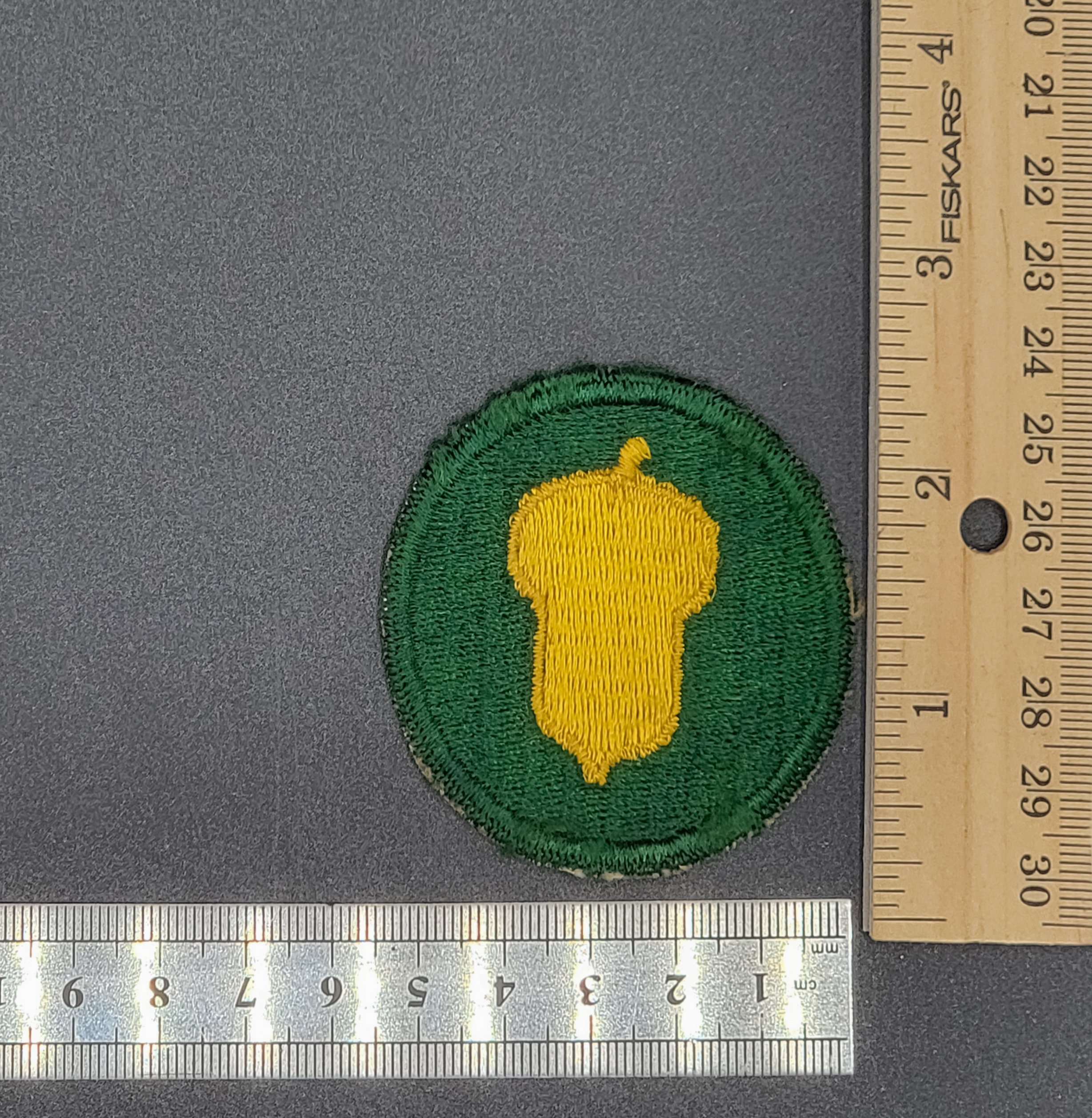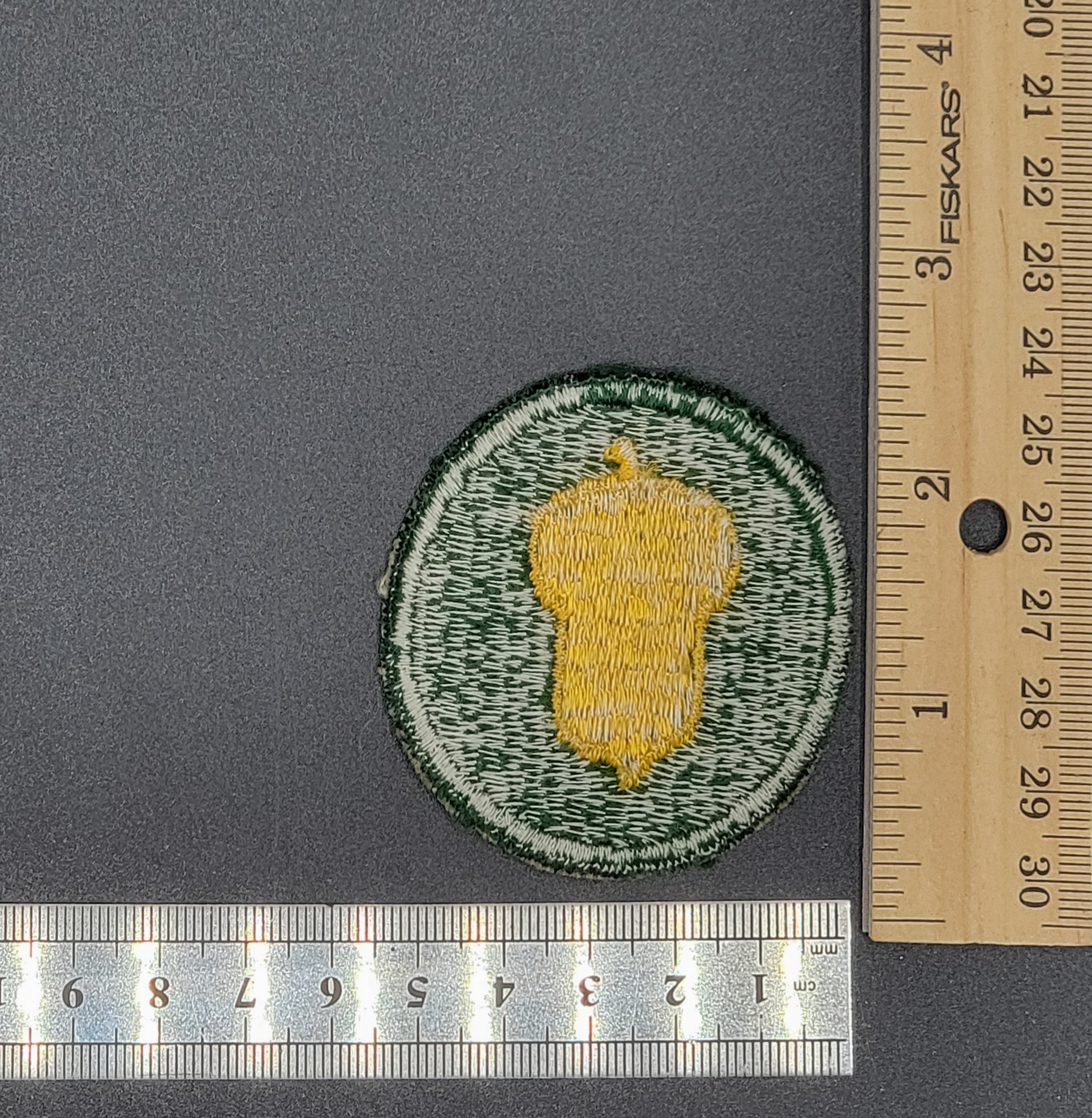87th Infantry Division "Golden Acorn" - SNOW BACK
The 87th Infantry Division arrived in Scotland, 22 October 1944, and trained in England, 23 October-30 November. It landed in France, 1–3 December, and moved to Metz, where, on 8 December, it went into action against and took Fort Driant. The division then shifted to the vicinity of Gros-Réderching near the Saar-German border on 10 December and captured Rimling, Obergailbach, and Guiderkirch.
The 87th was moving into Germany when, on 16 December 1944, German Field Marshal Von Rundstedt launched his offensive in the Ardennes forest (Battle of the Bulge). The Division was placed in SHAEF (Supreme Headquarters Allied Expeditionary Force) reserve, 24–28 December, then thrown into the Bulge battle in Belgium, 29 December. In a fluctuating battle, it captured Moircy on 30 December and Remagne on 31 December. On 2 January 1945, it took Gérimont, on 10 January Tillet, and reached the Ourthe by 13 January. On 15 January 1945, the division moved to Luxembourg to relieve the 4th Infantry Division along the Sauer and seized Wasserbillig on 23 January. The 87th moved to the vicinity of St. Vith, 28 January, and attacked and captured Schlierbach, Selz, and Hogden by the end of the month. After the fall of Neuendorf, 9 February, the division went on the defensive until 26 February, when Ormont and Hallschlag were taken in night attacks. The 87th crossed the Kyll River, 6 March, took Dollendorf on 8 March, and after a brief rest, returned to combat, 13 March 1945, crossing the Moselle on 16th and clearing Koblenz, 18–19 March. The division crossed the Rhine, 25–26 March, despite strong opposition, consolidated its bridgehead, and secured Grossenlinden and Langgöns. On 7 April, it jumped off in an attack which carried it through Thuringia into Saxony. Plauen fell, 17 April, and the division took up defensive positions, 20 April, about 4 miles from the border to Czechoslovakia. On 6 May 1945, it took Falkenstein and maintained its positions until Victory in Europe Day.
The 87th Division returned to the States in July 1945 expecting to be called upon to play a role in the defeat of the Imperial Japanese, but the sudden termination of the war in the Pacific while the division was reassembling at Fort Benning changed the future of the 87th. The division was inactivated 21 September 1945.
The last active soldier from the division that served in World War II retired in June 1981. Colonel Vedder B. Driscoll (1925–1983), who had enlisted in 1943 and was a platoon sergeant for Company I, 345th Infantry, achieved thirty years of commissioned service.
Casualties
Total battle casualties: 6,034
Killed in action: 1,154
Wounded in action: 4,342
Missing in action: 109
Prisoner of war: 429
The 87th Infantry Division arrived in Scotland, 22 October 1944, and trained in England, 23 October-30 November. It landed in France, 1–3 December, and moved to Metz, where, on 8 December, it went into action against and took Fort Driant. The division then shifted to the vicinity of Gros-Réderching near the Saar-German border on 10 December and captured Rimling, Obergailbach, and Guiderkirch.
The 87th was moving into Germany when, on 16 December 1944, German Field Marshal Von Rundstedt launched his offensive in the Ardennes forest (Battle of the Bulge). The Division was placed in SHAEF (Supreme Headquarters Allied Expeditionary Force) reserve, 24–28 December, then thrown into the Bulge battle in Belgium, 29 December. In a fluctuating battle, it captured Moircy on 30 December and Remagne on 31 December. On 2 January 1945, it took Gérimont, on 10 January Tillet, and reached the Ourthe by 13 January. On 15 January 1945, the division moved to Luxembourg to relieve the 4th Infantry Division along the Sauer and seized Wasserbillig on 23 January. The 87th moved to the vicinity of St. Vith, 28 January, and attacked and captured Schlierbach, Selz, and Hogden by the end of the month. After the fall of Neuendorf, 9 February, the division went on the defensive until 26 February, when Ormont and Hallschlag were taken in night attacks. The 87th crossed the Kyll River, 6 March, took Dollendorf on 8 March, and after a brief rest, returned to combat, 13 March 1945, crossing the Moselle on 16th and clearing Koblenz, 18–19 March. The division crossed the Rhine, 25–26 March, despite strong opposition, consolidated its bridgehead, and secured Grossenlinden and Langgöns. On 7 April, it jumped off in an attack which carried it through Thuringia into Saxony. Plauen fell, 17 April, and the division took up defensive positions, 20 April, about 4 miles from the border to Czechoslovakia. On 6 May 1945, it took Falkenstein and maintained its positions until Victory in Europe Day.
The 87th Division returned to the States in July 1945 expecting to be called upon to play a role in the defeat of the Imperial Japanese, but the sudden termination of the war in the Pacific while the division was reassembling at Fort Benning changed the future of the 87th. The division was inactivated 21 September 1945.
The last active soldier from the division that served in World War II retired in June 1981. Colonel Vedder B. Driscoll (1925–1983), who had enlisted in 1943 and was a platoon sergeant for Company I, 345th Infantry, achieved thirty years of commissioned service.
Casualties
Total battle casualties: 6,034
Killed in action: 1,154
Wounded in action: 4,342
Missing in action: 109
Prisoner of war: 429
The 87th Infantry Division arrived in Scotland, 22 October 1944, and trained in England, 23 October-30 November. It landed in France, 1–3 December, and moved to Metz, where, on 8 December, it went into action against and took Fort Driant. The division then shifted to the vicinity of Gros-Réderching near the Saar-German border on 10 December and captured Rimling, Obergailbach, and Guiderkirch.
The 87th was moving into Germany when, on 16 December 1944, German Field Marshal Von Rundstedt launched his offensive in the Ardennes forest (Battle of the Bulge). The Division was placed in SHAEF (Supreme Headquarters Allied Expeditionary Force) reserve, 24–28 December, then thrown into the Bulge battle in Belgium, 29 December. In a fluctuating battle, it captured Moircy on 30 December and Remagne on 31 December. On 2 January 1945, it took Gérimont, on 10 January Tillet, and reached the Ourthe by 13 January. On 15 January 1945, the division moved to Luxembourg to relieve the 4th Infantry Division along the Sauer and seized Wasserbillig on 23 January. The 87th moved to the vicinity of St. Vith, 28 January, and attacked and captured Schlierbach, Selz, and Hogden by the end of the month. After the fall of Neuendorf, 9 February, the division went on the defensive until 26 February, when Ormont and Hallschlag were taken in night attacks. The 87th crossed the Kyll River, 6 March, took Dollendorf on 8 March, and after a brief rest, returned to combat, 13 March 1945, crossing the Moselle on 16th and clearing Koblenz, 18–19 March. The division crossed the Rhine, 25–26 March, despite strong opposition, consolidated its bridgehead, and secured Grossenlinden and Langgöns. On 7 April, it jumped off in an attack which carried it through Thuringia into Saxony. Plauen fell, 17 April, and the division took up defensive positions, 20 April, about 4 miles from the border to Czechoslovakia. On 6 May 1945, it took Falkenstein and maintained its positions until Victory in Europe Day.
The 87th Division returned to the States in July 1945 expecting to be called upon to play a role in the defeat of the Imperial Japanese, but the sudden termination of the war in the Pacific while the division was reassembling at Fort Benning changed the future of the 87th. The division was inactivated 21 September 1945.
The last active soldier from the division that served in World War II retired in June 1981. Colonel Vedder B. Driscoll (1925–1983), who had enlisted in 1943 and was a platoon sergeant for Company I, 345th Infantry, achieved thirty years of commissioned service.
Casualties
Total battle casualties: 6,034
Killed in action: 1,154
Wounded in action: 4,342
Missing in action: 109
Prisoner of war: 429

